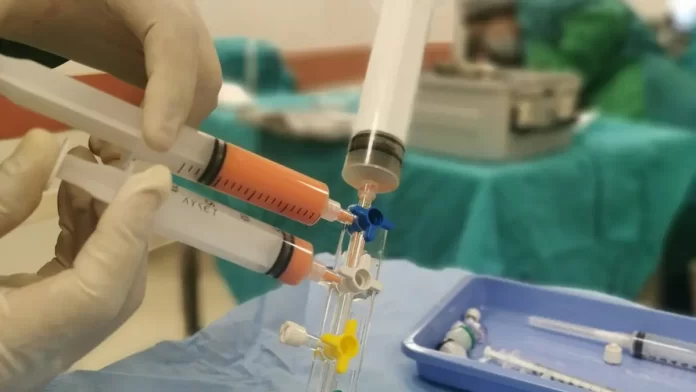Imagine a magical toolbox inside your body that contains special cells capable of transforming into various types of cells.
These extraordinary cells are called stem cells, and they hold immense potential in revolutionising the field of healthcare.
What are Stem Cells?
Stem cells are unique cells that have the remarkable ability to develop into different types of cells in the body.
They possess two essential characteristics-
- Self-renewal (the ability to divide and create more stem cells)
- Differentiation (the ability to specialize into specific cell types).
Stem cells play a crucial role in the development and repair of our bodies. They are responsible for the growth and renewal of tissues and organs throughout our lives.
Stem cells act as the building blocks that help to replace damaged cells, promoting healing and regeneration.
Sources of Stem Cells
There are different sources of stem cells. Embryonic stem cells are derived from human embryos and can develop into any type of cell in the body.
Adult stem cells exist in various tissues and organs, such as the bone marrow, skin, and blood.
Another source is induced pluripotent stem cells (iPSCs), which are reprogrammed adult cells that regain the ability to differentiate into different cell types.
The extraction of stem cells depends on their source. Embryonic stem cells are obtained from excess embryos donated by couples undergoing fertility treatments, with their informed consent.
Adult stem cells can be collected from various tissues through procedures like bone marrow aspiration or peripheral blood stem cell collection. iPSCs are generated by reprogramming adult cells using specific techniques in the laboratory.
Applications
Health
Stem cells hold immense potential in the field of healthcare. They offer promising avenues for treating various diseases and injuries. For example:
Regenerative Medicine: Stem cells can be used to replace damaged or diseased cells and tissues, offering potential treatments for conditions such as spinal cord injuries, heart disease, and diabetes. Scientists are exploring ways to guide stem cells to develop into specific cell types to repair or replace damaged organs.
Bone Marrow Transplants: Stem cells derived from bone marrow are used in life-saving bone marrow transplants to treat certain types of cancers, blood disorders, and immune system disorders.
Drug Development and Testing: Stem cells can be used to create disease models in the laboratory, allowing scientists to study diseases, test potential drug candidates, and develop personalized medicine approaches.
Agricultural Advancements
Stem cell technologies have the potential to revolutionize agriculture by improving crop yields, developing disease-resistant plants, and enhancing livestock breeding programs.
By using stem cells, scientists can manipulate the growth and development of plants and animals for better agricultural outcomes.
Cosmetic and Personal Care Products
Stem cells are used in the development of cosmetic and personal care products. For example, plant stem cells are incorporated into skincare products to promote skin regeneration and anti-aging effects.
These products claim to enhance skin health and appearance by stimulating collagen production and reducing the signs of aging.
Veterinary Medicine
Stem cell therapies have shown promise in veterinary medicine for treating injuries, orthopedic conditions, and diseases in animals.
This includes the use of stem cells for tissue regeneration in horses, dogs, and other animals. It offers a potential alternative to traditional treatments and surgeries.
Bioprinting and Tissue Engineering
Stem cells play a crucial role in bioprinting and tissue engineering. Researchers can use stem cells to create three-dimensional structures that resemble human tissues and organs.
These engineered tissues have applications in drug testing, disease modeling, and potentially as replacement tissues or organs for transplantation.
Toxicity Testing for Chemicals and Environmental Contaminants
Stem cells can be used to test the toxicity of chemicals and environmental contaminants.
By exposing stem cells to different substances, scientists can evaluate their effects on cellular function and determine potential risks to human health and the environment.
Research Tools
Stem cells serve as essential research tools for understanding human development, disease mechanisms, and cellular processes. Scientists use stem cells to study gene functions, disease pathways, and test new therapeutic approaches.
Future Scope of Stem Cells
The scope of stem cells is vast and holds tremendous promise for the future. Scientists and researchers are continuously exploring new avenues and advancements. For instance:
- Growing Organs: The ability to engineer organs from stem cells could potentially revolutionize transplantation, eliminating the need for donor organs and reducing waiting times.
- Neurodegenerative Diseases: Stem cell research offers hope in developing treatments for neurodegenerative diseases like Alzheimer’s and Parkinson’s, where the replacement of damaged neurons could restore function.
- Tissue Engineering: The combination of stem cells and innovative scaffold materials could lead to the creation of artificial tissues and organs, revolutionizing the field of tissue engineering.
Ethical Considerations and Regulations
The use of embryonic stem cells raises ethical concerns, as their extraction involves the destruction of human embryos.
However, research efforts are being made to develop alternative sources, such as iPSCs, to overcome these ethical dilemmas.
Additionally, governments and regulatory bodies have established guidelines to ensure responsible and ethical practices in stem cell research.
Conclusion
Stem cells are like tiny superheroes within our bodies, with the power to heal, repair, and potentially transform the field of healthcare.
From regenerative medicine to organ transplantation, their applications are vast and hold incredible promise.
As scientists continue to explore and unlock the potential of stem cells, we can look forward to a future where previously incurable diseases may find cures and where personalized medicine becomes a reality.
